超详细的状语和状语从句讲解
- 格式:ppt
- 大小:856.00 KB
- 文档页数:73
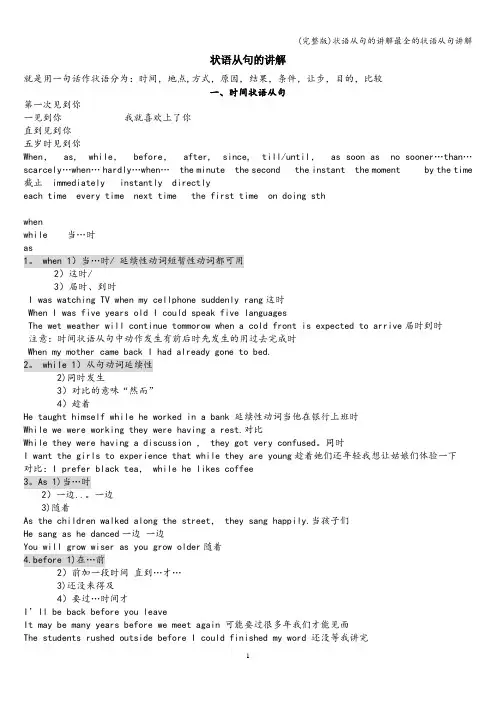
状语从句的讲解就是用一句话作状语分为:时间,地点,方式,原因,结果,条件,让步,目的,比较一、时间状语从句第一次见到你一见到你我就喜欢上了你直到见到你五岁时见到你When, as, while, before, after, since, till/until, as soon as no sooner…than…scarcely…when…hardly…when… the minute the second the instant the moment by the time 截止 immediately instantly directlyeach time every time next time the first time on doing sthwhenwhile 当…时as1。
when 1)当…时/ 延续性动词短暂性动词都可用2)这时/3)届时、到时I was watching TV when my cellphone suddenly rang这时When I was five years old I could speak five languagesThe wet weather will continue tommorow when a cold front is expected to arrive届时到时注意:时间状语从句中动作发生有前后时先发生的用过去完成时When my mother came back I had already gone to bed.2。
while 1)从句动词延续性2)同时发生3)对比的意味“然而”4)趁着He taught himself while he worked in a bank 延续性动词当他在银行上班时While we were working they were having a rest.对比While they were having a discussion , they got very confused。
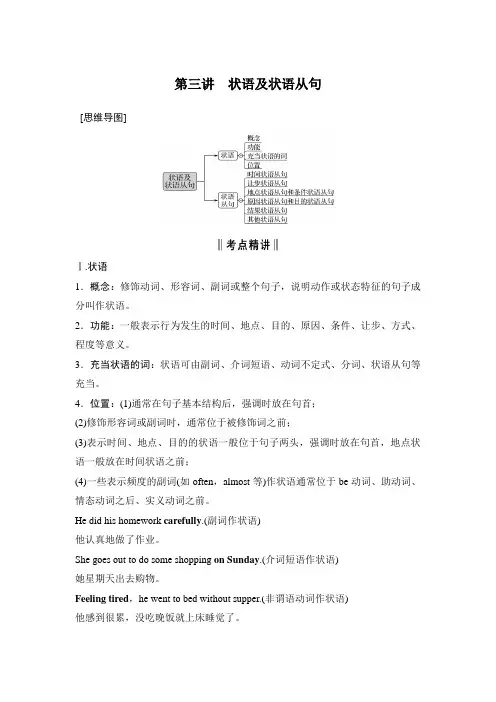
第三讲状语及状语从句[思维导图]Ⅰ.状语1.概念:修饰动词、形容词、副词或整个句子,说明动作或状态特征的句子成分叫作状语。
2.功能:一般表示行为发生的时间、地点、目的、原因、条件、让步、方式、程度等意义。
3.充当状语的词:状语可由副词、介词短语、动词不定式、分词、状语从句等充当。
4.位置:(1)通常在句子基本结构后,强调时放在句首;(2)修饰形容词或副词时,通常位于被修饰词之前;(3)表示时间、地点、目的的状语一般位于句子两头,强调时放在句首,地点状语一般放在时间状语之前;(4)一些表示频度的副词(如often,almost等)作状语通常位于be动词、助动词、情态动词之后、实义动词之前。
He did his homework carefully.(副词作状语)他认真地做了作业。
She goes out to do some shopping on Sunday.(介词短语作状语)她星期天出去购物。
Feeling tired,he went to bed without supper.(非谓语动词作状语)他感到很累,没吃晚饭就上床睡觉了。
Ⅱ.状语从句一、时间状语从句1.when,while与as引导的时间状语从句Metals expand when they are heated.金属受热时膨胀。
While /When I was reading,he came in.我正在看书时,他进来了。
The students sang as they walked.学生们边走边唱。
2.before与since引导的时间状语从句(1)before与since的常用句式It will be half a year before I come back.我半年之后才回来。
It won’t be long before we meet again.用不了多久我们就会再见面。
It was three days before he came back.三天后他才回来。
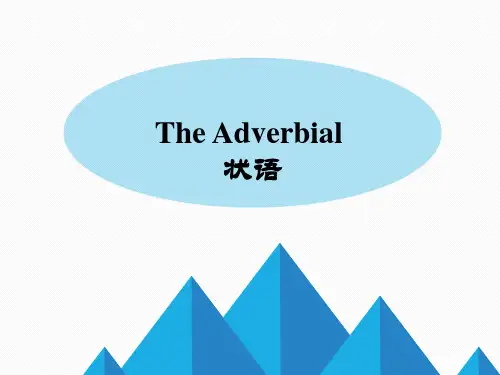
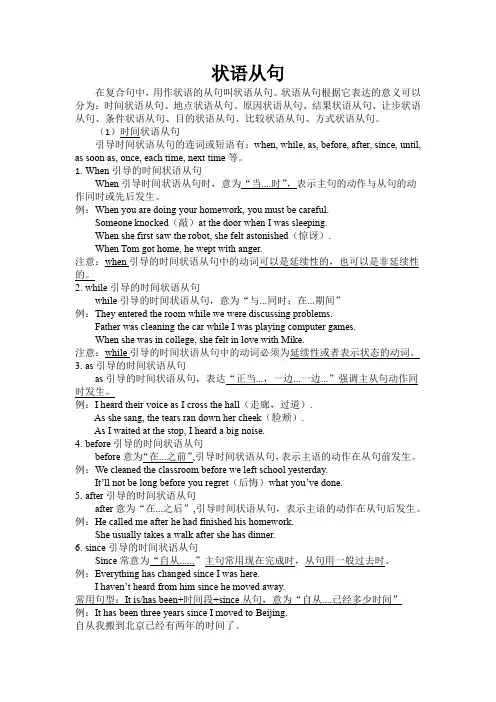
状语从句在复合句中,用作状语的从句叫状语从句。
状语从句根据它表达的意义可以分为:时间状语从句、地点状语从句、原因状语从句、结果状语从句、让步状语从句、条件状语从句、目的状语从句、比较状语从句、方式状语从句。
(1)时间状语从句引导时间状语从句的连词或短语有:when, while, as, before, after, since, until, as soon as, once, each time, next time等。
1.When引导的时间状语从句When引导时间状语从句时,意为“当....时”,表示主句的动作与从句的动作同时或先后发生。
例:When you are doing your homework, you must be careful.Someone knocked(敲)at the door when I was sleeping.When she first saw the robot, she felt astonished(惊讶).When Tom got home, he wept with anger.注意:when引导的时间状语从句中的动词可以是延续性的,也可以是非延续性的。
2.while引导的时间状语从句while引导的时间状语从句,意为“与...同时;在...期间”例:They entered the room while we were discussing problems.Father was cleaning the car while I was playing computer games.When she was in college, she felt in love with Mike.注意:while引导的时间状语从句中的动词必须为延续性或者表示状态的动词。
3.as引导的时间状语从句as引导的时间状语从句,表达“正当...,一边...一边...”强调主从句动作同时发生。
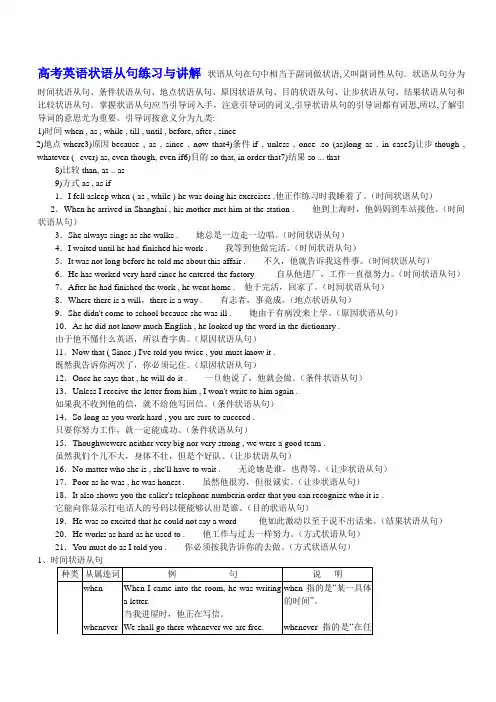
高考英语状语从句练习与讲解状语从句在句中相当于副词做状语,又叫副词性从句。
状语从句分为时间状语从句、条件状语从句、地点状语从句、原因状语从句、目的状语从句、让步状语从句、结果状语从句和比较状语从句。
掌握状语从句应当引导词入手,注意引导词的词义,引导状语从句的引导词都有词思,所以,了解引导词的意思尤为重要。
引导词按意义分为九类:1)时间when , as , while , till , until , before, after , since2)地点where3)原因because , as , since , now that4)条件if , unless , once .so (as)long as . in case5)让步though , whatever (--ever) as, even though, even if6)目的so that, in order that7)结果so ... that8)比较than, as .. as9)方式as , as if1.I fell asleep when ( as , while ) he was doing his exercises .他正作练习时我睡着了。
(时间状语从句)2.When he arrived in Shanghai , his mother met him at the station .他到上海时,他妈妈到车站接他。
(时间状语从句)3.She always sings as she walks .她总是一边走一边唱。
(时间状语从句)4.I waited until he had finished his work .我等到他做完活。
(时间状语从句)5.It was not long before he told me about this affair .不久,他就告诉我这件事。
(时间状语从句)6.He has worked very hard since he entered the factory 自从他进厂,工作一直很努力。
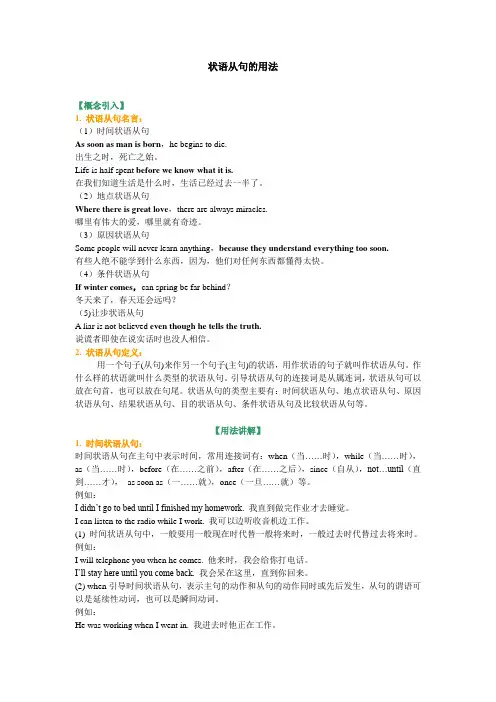
状语从句的用法【概念引入】1. 状语从句名言:(1)时间状语从句As soon as man is born,he begins to die.出生之时,死亡之始。
Life is half spent before we know what it is.在我们知道生活是什么时,生活已经过去一半了。
(2)地点状语从句Where there is great love,there are always miracles.哪里有伟大的爱,哪里就有奇迹。
(3)原因状语从句Some people will never learn anything,because they understand everything too soon.有些人绝不能学到什么东西,因为,他们对任何东西都懂得太快。
(4)条件状语从句If winter comes,can spring be far behind?冬天来了,春天还会远吗?(5)让步状语从句A liar is not believed even though he tells the truth.说谎者即使在说实话时也没人相信。
2. 状语从句定义:用一个句子(从句)来作另一个句子(主句)的状语,用作状语的句子就叫作状语从句。
作什么样的状语就叫什么类型的状语从句。
引导状语从句的连接词是从属连词,状语从句可以放在句首,也可以放在句尾。
状语从句的类型主要有:时间状语从句、地点状语从句、原因状语从句、结果状语从句、目的状语从句、条件状语从句及比较状语从句等。
【用法讲解】1. 时间状语从句:时间状语从句在主句中表示时间,常用连接词有:when(当……时),while(当……时),as(当……时),before(在……之前),after(在……之后),since(自从),not…until(直到……才),as soon as(一……就),once(一旦……就)等。
例如:I didn’t go to bed until I finished my homework. 我直到做完作业才去睡觉。
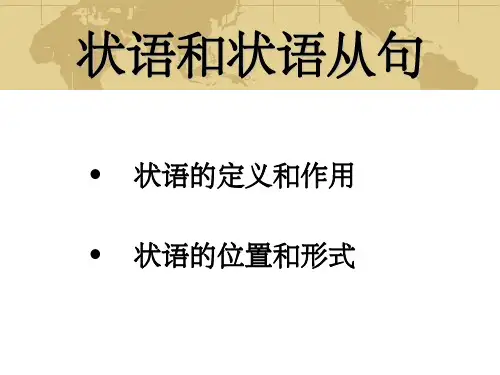
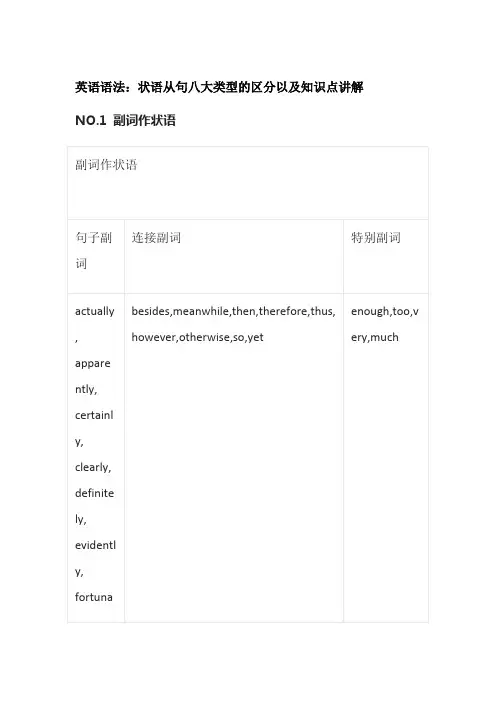
英语语法:状语从句八大类型的区分以及知识点讲解NO.1 副词作状语(1)句子副词:句子副词用于修饰句子(而不是修饰某个单个的词),反映说话人的观点和看法。
如actually, apparently, certainly, clearly,definitely, evidently, fortunately, frankly, honestly, luckily, obviously, perhaps, possibly, probably, surely, undoubtedly, unexpectedly 等。
作用以及位置:句子副词通常位于句首(或分句句首)。
Eg:Obviously he can't tell the difference between them. 显然他无法区别两者的不同。
I arrived late but luckily the meeting had been delayed. 我迟到了,幸而会议推迟了。
但有些句子副词也可以出现句中。
eg:He smiled nastily. He evidently knew something I didn't. 他发出狞笑,他显然知道一些我所不知道的事。
有的句子也可用作其他种类的副词,不过这往往会导致位置和语义的变化:Clearly he didn't say so. 显然他没有这样说。
(句子副词)He didn't say so clearly. 他说得没有那么清楚。
(方式副词)(2)起连词作用的副词连接副词就是连接词,如besides,meanwhile,then, therefore, thus, However,Otherwise, so, yet 等。
作用以及位置:常放在两个句子中间,前面为逗号,后面放连接词,从句之前。
注意:so 也可放在形容词之前做修饰,yet 可放句尾或从句之前。
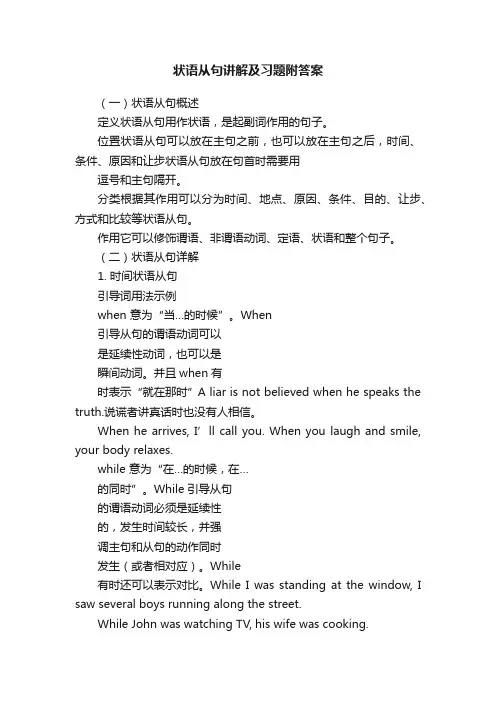
状语从句讲解及习题附答案(一)状语从句概述定义状语从句用作状语,是起副词作用的句子。
位置状语从句可以放在主句之前,也可以放在主句之后,时间、条件、原因和让步状语从句放在句首时需要用逗号和主句隔开。
分类根据其作用可以分为时间、地点、原因、条件、目的、让步、方式和比较等状语从句。
作用它可以修饰谓语、非谓语动词、定语、状语和整个句子。
(二)状语从句详解1. 时间状语从句引导词用法示例when 意为“当…的时候”。
When引导从句的谓语动词可以是延续性动词,也可以是瞬间动词。
并且when有时表示“就在那时”A liar is not believed when he speaks the truth.说谎者讲真话时也没有人相信。
When he arrives, I’ll call you. When you laugh and smile, your body relaxes.while 意为“在…的时候,在…的同时”。
While引导从句的谓语动词必须是延续性的,发生时间较长,并强调主句和从句的动作同时发生(或者相对应)。
While有时还可以表示对比。
While I was standing at the window, I saw several boys running along the street.While John was watching TV, his wife was cooking.as 意为“一边…一边…”。
As引导的动作是延续性的,发生时间较短,一般用于主句和从句动作同时发生;as也可以强调一前一后。
The writer was angry as he was travelling on a train to London because someone had invaded his “space”.He smiled as he stood up.after 意为“在…之后”。
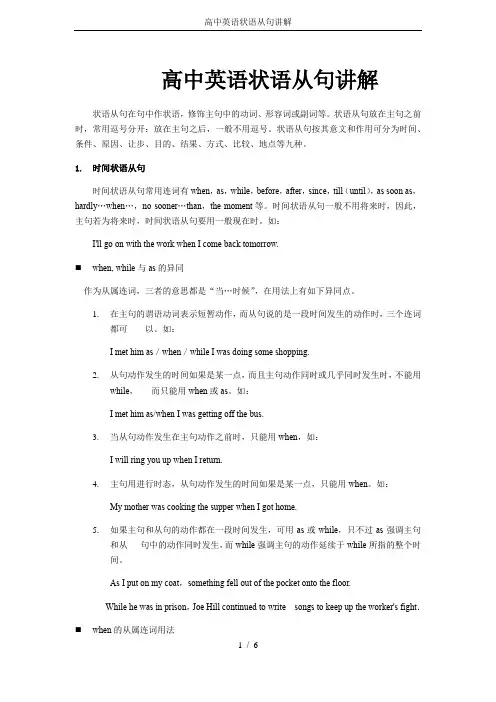
高中英语状语从句讲解状语从句在句中作状语,修饰主句中的动词、形容词或副词等。
状语从句放在主句之前时,常用逗号分开:放在主句之后,一般不用逗号。
状语从句按其意文和作用可分为时间、条件、原因、让步、目的、结果、方式、比较、地点等九种。
1.时间状语从句时间状语从句常用连词有when,as,while,before,after,since,till(until),as soon as,hardly…when…,no sooner…than,the moment等。
时间状语从句一般不用将来时,因此,主句若为将来时,时间状语从句要用一般现在时。
如:I'll go on with the work when I come back tomorrow.⏹when, while与as的异同作为从属连词,三者的意思都是“当…时候”,在用法上有如下异同点。
1.在主句的谓语动词表示短暂动作,而从句说的是一段时间发生的动作时,三个连词都可以。
如:I met him as/when/while I was doing some shopping.2.从句动作发生的时间如果是某一点,而且主句动作同时或几乎同时发生时,不能用while,而只能用when或as。
如:I met him as/when I was getting off the bus.3.当从句动作发生在主句动作之前时,只能用when,如:I will ring you up when I return.4.主句用进行时态,从句动作发生的时间如果是某一点,只能用when。
如:My mother was cooking the supper when I got home.5.如果主句和从句的动作都在一段时间发生,可用as或while,只不过as强调主句和从句中的动作同时发生,而while强调主句的动作延续于while所指的整个时间。
As I put on my coat,something fell out of the pocket onto the floor.While he was in prison,Joe Hill continued to write songs to keep up the worker's fight.⏹when的从属连词用法when作为从属连词引导时间状语从句,既可放在主句之前,也可放在主句之后。
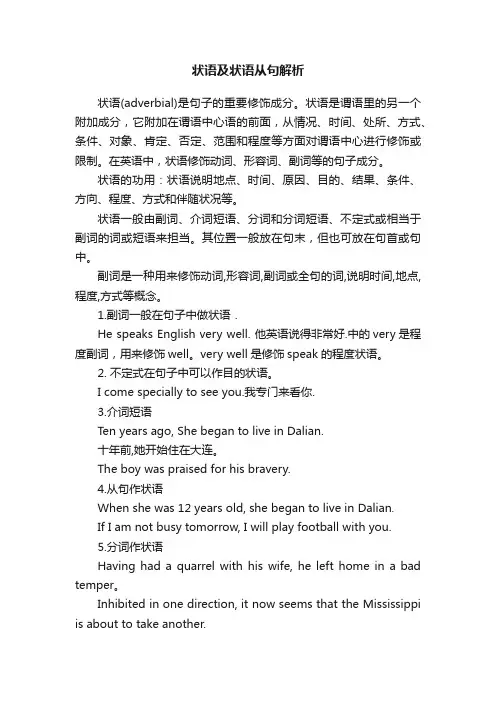
状语及状语从句解析状语(adverbial)是句子的重要修饰成分。
状语是谓语里的另一个附加成分,它附加在谓语中心语的前面,从情况、时间、处所、方式、条件、对象、肯定、否定、范围和程度等方面对谓语中心进行修饰或限制。
在英语中,状语修饰动词、形容词、副词等的句子成分。
状语的功用:状语说明地点、时间、原因、目的、结果、条件、方向、程度、方式和伴随状况等。
状语一般由副词、介词短语、分词和分词短语、不定式或相当于副词的词或短语来担当。
其位置一般放在句末,但也可放在句首或句中。
副词是一种用来修饰动词,形容词,副词或全句的词,说明时间,地点,程度,方式等概念。
1.副词一般在句子中做状语.He speaks English very well. 他英语说得非常好.中的very是程度副词,用来修饰well。
very well是修饰speak的程度状语。
2. 不定式在句子中可以作目的状语。
I come specially to see you.我专门来看你.3.介词短语Ten years ago, She began to live in Dalian.十年前,她开始住在大连。
The boy was praised for his bravery.4.从句作状语When she was 12 years old, she began to live in Dalian.If I am not busy tomorrow, I will play football with you.5.分词作状语Having had a quarrel with his wife, he left home in a bad temper。
Inhibited in one direction, it now seems that the Mississippi is about to take another.状语简介概述状语与定语相同的地方是,都是前者附加成分;不同的地方是,它是谓语里的附加成分,而定语是主语或宾语里的附加成分.从句子的层次上看,状语是在第二个层次和第三个层次里的成分,有时甚至是更低层次的成分.状语的构成状语的构成经常充当状语的有形容词,副词,时间处所名词,能愿动词,指示代词,以及方位短语,介词短语,动宾短语,谓词性联合短语,谓词性偏正短语,谓词性主谓短语等.含有动量词的数量短语以及重叠式的数量短语(不论动量,物量)也可以充当状语.此外,少数名词带上表比况的助词也可以作状语.状语的书面标志——"地"状语的书面标志是结构助词"地".状语后面带或者是不带"地",情况比较复杂.一般讲来,数量短语,主谓短语,动宾短语等作状语时,大都带"地";而介词短语,方位短语,能愿动词,时间处所名词作状语时不能带"地",副词,单音节形容词作状语一般也不带"地".多层状语如果一个中心语前面有好几个状语(多层状语),那就应当注意它们的语序.多层状语的状语个数一般比多层定语的定语个数要少些,其语序也比多层定语的语序要灵活一些.多层状语的一般语序:a.表时间的名词或方位短语,介词短语;b.副词.c.表处所的介词短语或名词,方位短语;d.表情态的形容词或谓词短语;e.表对象的介词短语.其中副词的位置较为灵活,也可放置在第三项之后.一般状语和句首状语状语在句子中有两种位置:一种是在主语之后,谓语中心之前,如上文所举各例,这是状语的一般位置;另一种是放在主语的前面的,这是状语的特殊位置,这种状语可称"句首状语".状语的分类状语按其修饰的功能不同可分为八大类:时间状语,地点状语,条件状语,原因状语,目的状语,结果状语,让步状语和比较状语时间状语从句要点: 时间状语从句,由以下连词引导:when ,while,as,after ,before,as soon as,since ,till /until by the time 在时间状语从句中,要注意时态一致。
状语从句(Adverbial Clause)状语从句指句子用作状语时,起副词作用的句子。
它可以修饰谓语、非谓语动词、定语、状语或整个句子。
根据其作用可分为时间、地点、原因、条件、目的、结果、让步、方式和比较等从句。
状语从句一般由连词(从属连词)引导,也可以由词组引起。
从句位于句首或句中时通常用逗号与主句隔开,位于句尾时可以不用逗号隔开。
状语从句的种类状语从句可分为:1.时间状语从句;(adverbial clause of time)2.地点状语从句;(adverbial clause of place)3.原因状语从句;(adverbial clause of cause)4.条件状语从句;(adverbial clause of condition)5.目的状语从句;(adverbial clause of purpose)6.让步状语从句;(adverbial clause of concession)7.比较状语从句;(adverbial clause of comparison)8.方式状语从句;(adverbial clause of manner)9.结果状语从句。
(adverbial clause of result)[编辑本段]状语从句的时态特点一般情况下,时间和条件状语从句的谓语动词一般用“一般现在时”表示“一般将来时”,用“现在完成时”表示“将来完成时”。
例如:I will call you as soon as I arrive in Beijing. 我一到北京就给你打电话。
(这是由as soon as引导的时间状语从句,从句中的谓语动词arrive是一般现在时,表示一般将来时,决不可用will arrive)As soon as I have finished this work, I will go home. 我一完成此工作,就回家。
(从句中的谓语动词用现在完成时have finished,表示将来完成时,决不可用will have finished)If he comes back, please let me know.如果他回来了,请通知我。
定语从句定语从句是由关系代词和关系副词引导的从句,其作用是作定语修饰主句的某个成分,定语从句分为限定性和非限定性从句两种。
状语从句分为时间状语从句,结果状语从句,让步状语从句,原因状语从句,条件状语从句以及行为方式状语从句。
名词从句包括主语从句,宾语从句,表语从句和同位语从句及there be句型。
一、限定性定语从句1. that即可代表事物也可代表人,which代表事物;它们在从句中作主语或宾语,that在从句中作宾语时常可省略关系词,which在从句中作宾语则不能省略。
而且,如果which在从句中作“不及物动词+介词”的介词的宾语,注意介词不要丢掉,而且介词总是放在关系代词which的前边,但有的则放在它原来的位置2. which作宾语时,根据先行词与定语从句之间的语义关系,先行词与which之间的介词不能丢3. 代表物时多用which,但在带有下列词的句子中用that而不用which,这些词包括all, anything, much等,这时的that常被省略4. who和whom引导的从句用来修饰人,分别作从句中的主语和宾语,whom 作宾语时,要注意它可以作动词的宾语也可以作介词的宾语5. where是关系副词,用来表示地点的定语从句6. when引导定语从句表示时间〔注〕值得一提的是,表示时间“time"一词的定语从句只用when引导,有时不用任何关系代词,当然也不用that引导By the time you arrive in London, we will have stayed there for two weeks.I still remember the first time I met her.Each time he goes to besiness trip, he brings a lot of living necessities, such as towers, soap, toothbrush etc.7. whose是关系代词,修饰名词作定语,相当于所修饰成分的前置所有格8. 当从句的逻辑主语是some, any, no, somebody, anybody, nobody, something, anything, everything或nothing时,常用there is来引导二、非限定性定语从句:非限定性定语从句的作用是对所修饰的成分作进一步说明,通常和主句间用逗号隔开,将从句拿掉后其他部分仍可成立1. which引导的非限定性定语从句来说明前面整个句子的情况或主句的某一部分2. 在引导限定性定语从句时,that有时相当于in which, at which, for which或at whichAttitudes towards daydreaming are changing in much the same way that(in which) attitudes towards night dreaming have changed. 人们对白日做梦的态度正在改变,这与人们对夜间做梦的看法的变化有非常相似之处。
英语句型分析之状语从句(完整版)状语从句⽤来修饰主句中的动词,副词和形容词的从句叫状语从句。
时间状语从句 when, whenever, while, as, before, after, since, till, once, as soon as,etc.地点状语从句 where,wherever原因状语从句 because, since, as, for, now that, etc.⽬的状语从句 in order that, so that, that, etc.结果状语从句 so…that, so that, such…that, that, etc.条件状语从句 if, unless, as(so)long as, etc.让步状语从句 though, although, even if, even though, however, whatever, as,etc.⽐较状语从句 as…as, so…as, than, etc.⽅式状语从句 as, as if, as though, etc1. 时间状语从句(1)时间状语从句常⽤when, as, while, before, after, since, till, until, as soon as等连词来引导。
e.g.It was raining hard when got to school yesterday.e.g.After he finished middle school, he went to work in a factory.在时间状语从句⾥,通常不⽤将来时态,⽤现在时态表⽰将来的动作或状态。
e.g.I’ll ring you up as soon as I get to New York.在带有till或until引导的时间状语从句的主从复合句⾥,如果主句⽤肯定式,其含义是“⼀直到……时”,谓语动词只能⽤延续性动词。
状语从句状语从句在句中作状语,可分为:时间、条件、让步、原因、目的、结果、比较、地点、方式状语从句。
一、时间状语从句引导时间状语从句的连词有:when, as, while, until, not…until, before, after, since, the minute, the moment, each( every, next, the first) time等。
时间状语从句中一般用一般现在时或一般过去时。
1.When , while, as都可解释为“当```的时候”但侧重点有所不同。
1)WhenEg: When I arrived home , I had a little rest.注意点:when 从句的主语与主句主语相同,谓语动词是be 动词时,从句主语和be可以省略。
Eg: When (she was) walking along the street, she met her class teacher.2)AsAs 除了表示“当```的时候”,还可表示为“一面```一面”,“随着”Eg: He sang as he danced.(一面```一面)You will grow wiser as you grow older.(随着)3)While表示“当```的时候”强调主句的动作和从句的动作同时发生,从句一般用进行时,从句动词必须是延续性动词。
Eg: While we were working, they were having a rest.While (they were) having a discussion, they got very confused.注意点:while 有对比的含义,解释为“然而”。
eg: I prefer black tee, while he likes coffee.2.until, not…until表示“直到```才”,在肯定句中主句常用延续性动词;在否定句中主句常用短暂性动词。